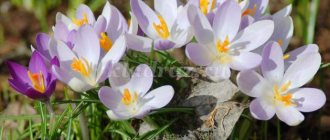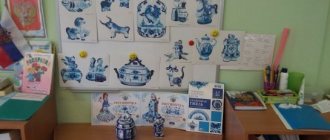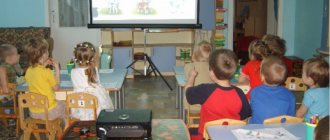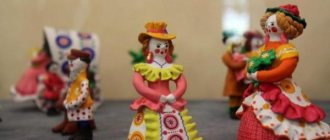"Cockerel and his family"
Transcript
1 Municipal autonomous educational institution “Kindergarten 40. Child Development Center” Summary of a lesson on speech development “Cockerel and his family” First junior group Compiled by teacher S.N. Sheverdyaeva Ruza
2 Goal: to expand children’s vocabulary through folklore works. Objectives: Educational: - learn to distinguish and name a cockerel, hen and chick - form cognitive activity - learn to answer the teacher's questions Developmental: - develop the ability to play together - form cognitive activity, introducing to the national culture - develop motor activity, thinking, imagination Educational: — cultivate a friendly attitude towards animals, love for nature Planned results: knows how to distinguish and name a cockerel, hen, chick and imitate their voices; knows how to answer the teacher’s questions, perform movements in the game in accordance with the text; shows interest in games and fiction. Equipment: a screen with pictures, which consists of four stripes: One side: 1 strip white background 2 strip cockerel 3 strip hen 4 strip chicks Second side: 1 strip image of a river 2 strip house 3 strip yard 4 strip - forest Contents of organized children's activities. 1. Motivation. There is a knock on the door. - Children, someone is knocking on our door. Let's see who came to us? (Yes).
3 The teacher brings in a cockerel (toy). - Who are these guys? (cockerel) - Correct. Now he will tell you about his family. 2. The main part of the lesson. “Cockerel” The screen is installed in the shape of a tetrahedral prism, with the white side facing the children. Educator: Children, who sings “ku-ka-re-ku!”? Does he get up early and doesn't let the kids sleep? Children: Cockerel! Educator: Let's call him: “Cockerel, cockerel!” Come to us!" (pause) It doesn't work! Do you remember the poems about the cockerel? We will tell you, the cockerel will hear and come. Cockerel, cockerel, Golden comb, Butter head, Silk beard, Why do you get up early, Sing loudly, Don’t let the kids sleep? Let's call the cockerel! Cockerel, golden comb, come to us! (an image of a cockerel appears in front of the children, the children look at the picture) Ku-ka-re-ku! Hello kids! The teacher draws the children's attention to the features of the bird: comb, feathers, beak, legs. The nursery rhyme is read again. "Hen". Educator. Who is the cockerel calling? How do you think? Right! Chicken! (a chicken appears in front of the children). Ko-ko-ko! (the screen folds into a triangular prism, the clean side covers the chickens). The screen turns, the chicken disappears. Gone! Let's call her! Ruffed chicken! Come to us. (an image of a chicken appears). Ko-ko-ko! What a chicken! Beak, paws. How does she cackle? Where, whack, whack! Children. Where, whack, whack! Ko-ko-ko!
4 "The Cockerel and the Hen." The screen is opened in the shape of the letter P. In front of the children, an image of a cockerel and a hen appears. The teacher makes a comparison: the cockerel has a comb, a beard and a bushy tail, and the chicken has a small comb and a small tail. Educator: Our chickens through the window: Ko-ko-ko! Ko-ko-ko! And how Petya the Cockerel sings to us early in the morning: Ku-ka-re-ku! (Children look at the hen and the cockerel.) Educator: The tarot hen walks around the yard, inflates its crest, calls the little children: Co-co-co! Who is the chicken calling? Chick! (the screen folds into a cube, an image of chickens appears in front of the children.) “Chickens.” Educator. Children, look at these chickens! Small, yellow, fluffy! How do they squeak? “Peep-pee-pee!” - the chickens squeak, the mother hen is called. "The Hen and the Chicks." (The screen is folded in the shape of the letter L, in front of the children is an image of a hen and chickens.) Educator. Children are like a hen calling her chicks? (Ko-ko-ko!). How do chickens squeak? (Peep-pee-pee!). The tarot hen walks around the yard, inflates her crest, and amuses the little children: “Ko-ko-ko!”
5 What will the chickens answer her? Pee-pee-pee! P-i-t. What's happened? Why do chickens squeak so loudly? What they want? Drink! “The chicken went for some water.” (The screen is folded in the shape of the letter L; a picture of a chicken walking to the river appears in front of the children). Educator: Little hen, where did you go? - To the river! Little hen, why did you go? -Get some water. Little hen, why do you need some water? -Water the chickens. Little hen, How do chickens ask for water? - Pee-pee-pee. “Chicks and a cockerel” (The screen folds into a triangular prism, and an image of a cockerel appears in front of the children). Educator. The cockerel heard the chickens crying pitifully. He began to call the chicken. (The image of chickens is superimposed on the hen. The screen is in the shape of the letter G. An image of a cockerel appears in front of the children against the backdrop of the forest). Cockerel, cockerel, Golden comb, You raise your voice Through the dark woods, Through the forest across the river Shout “ku-ka-re-ku!” "The hen, the cockerel and the chicks." Educator. The hen heard the rooster calling her, and came and brought a bucket full of water. The entire exhibition unfolds, in front of the children is an image of a cockerel, hen and chicks.
6 How at our gates the Rooster pecks the grains, the Rooster pecks the grains, calls the hen to him! Ku-ka-re-ku! Give everyone a drink, chicken! "Song about a chicken." The teacher invites the children to sing a song about a chicken: The chicken went out for a walk, To pinch some fresh grass, And behind her the children, Yellow chickens! Ko-ko-ko! Ko-ko-ko! Don't go far! Row with your paws! Look for the grains! Children walk around the room and perform movements after the teacher. The lesson ends.
MAGAZINE Preschooler.RF
Summary of direct educational activities on speech development for children of the early age group “Cockerel and his family.”Goal: To introduce children to poultry: cockerel, hen, chicks.
Tasks:
Educational:
- Introduce children to the concept of “family” .
- Learn to answer questions in words and sentences;
- to develop the ability for dialogical speech.
- Distinguish and name words with opposite meanings (big-small).
- Learn to recognize and name the characteristic external features of a bird (beak, wings, feathers, comb, beard);
- learn to correlate speech with movement when playing a nursery rhyme;
Activate your vocabulary using the words: hen, cockerel, chickens, chick, pecks, big, small. "beard" , "comb" .
Developmental:
- Develop speech hearing and speech activity in children, encourage onomatopoeia
- Develop communication skills. Stimulate speech development and the motor side of speech through the development of fine motor skills and tactile sensations.
- Develop children's mental processes: attention, memory, thinking.
Educational:
- Cultivate a caring attitude towards birds. Emotional responsiveness. The desire to care and help loved ones.
Integration of educational areas: speech development, social and communicative development, cognitive development, artistic and aesthetic development, physical development.
Preliminary work
- Conversations on the topic “Domestic animals and their young”
- Didactic games “Who eats what” , “Who gives what voice?”
- Looking at the painting “Rooster Family”
- Reading poems and asking riddles on the topic “Pets”
- Reading Russian folklore works that tell about a cockerel, a hen, and chickens.
- Listening to music: A. Filippenko “Chickens”
- Learning the M/P game “Chickens”
- Learning the nursery rhyme “Cockerel”
Facilities:
- organizational (tables, masks for playing, model of a poultry yard, millet, clothespins)
- methodological (visual aids (round base-sun, image of a cockerel, hen, chicks), pictures with the image “Poultry yard” )
- technical (recording of voices: cockerel, hens, chicks, poultry yard; laptop, DVD with images on the topic, etc.)
Main part.
I. Organizational moment:
Educator: Guys, look, a guest came to us today. She will watch how you can play and have fun; how beautiful and good you all are. Let's say hello to her and give her our smiles!
Articulation gymnastics “Smile” pulled the lips to the ears, smiled like frogs.
Educator: Guys! Today we have a fun, joyful day. Everyone is in a good mood, but for some reason our sun is sad.
Educator: Let's cheer up the sun. (motivation).
- We will give him some rays. (development of fine motor skills)
(Take yellow clothespins and attach them to the round base).
Educator: What color clothespins did you attach? Finally, the sun woke up and began to shine!
II. Main part.
Educator: Who gets up with the sun and sings songs loudly? He doesn’t let the kids sleep and sings... (an audio recording of “ku-ka-re-ku” ).
-Who is screaming so loudly? (Cockerel).
Educator: Let's call him: “Cockerel, cockerel! Come to us!" (the phrase is repeated).
Educator: What a beautiful cockerel!
(An image of a cockerel appears in front of the children. The children examine the cockerel.
The teacher offers to show where the cockerel's eyes, tail, beak, paws, head, and wings are.
The teacher draws attention to the characteristics of the cockerel:
- The rooster is large, he has a red comb and beard on his head, he has a lush, beautiful tail, bright feathers.
Breathing exercises “Feather” .
Teacher (blows on a feather and releases it, the children watch it fly, the teacher offers to play with the feathers)
- Do you want to blow on it too (children’s answers).
Educator: How does the cockerel sing?
Invite the children to remember the nursery rhyme about the cockerel!
Cockerel, golden comb cockerel. Oil head, Silk beard.
Why do you get up early? Do you sing songs loudly? Don't you let the kids sleep? Children: “Ku-ka-re-ku!”
(development of speech hearing, development of the motor side of speech and the ability to imitate the voices of poultry)
(audio recording of “chicken clucking” ).
Educator: And who is that there, guys, cackling? (Hen)
-Let's call the chicken. What are we going to call her? (chick - chick - chick)
Educator: Look, is the chicken the same as the cockerel?
(distinguish between sizes: size - “big – small” )
The cockerel is big, and the chicken... (I encourage you to finish the sentence)
The cockerel has a large tail, while the chicken has a small tail.
How does the chicken talk? (ko - ko - ko)
The cockerel is the daddy, and what about the hen? (Mother). They have baby chickens. And together they are a family.
Educator: Oh, let's tell you about your family.
Finger game: “My Family”
The game consists of saying a nursery rhyme:
This finger is grandpa, This finger is grandma, This finger is daddy, This finger is mommy,
This finger is me.
(development of fine motor skills of hands, speech, interest in folklore, attentiveness, ability to concentrate; nurturing good relationships between children, adults and children).
Educator: Guys, but the chicken came alone, without chickens, all her children were chickens, they went out for a walk with her and ran away in all directions, she did not have time to catch them, and now she is afraid that the chickens will not return to her.
- Do you want to help the chicken? Remember what chickens eat?
- That's right, chickens peck grains.
(The teacher, together with the students, examines the grains, says that the grains
round, yellow, hard and small because chickens have small beaks).
Educator: Let's pour grains for the chickens and they will return to their mother chicken.
(sprinkle grains - development of fine motor skills)
Educator: Guys, how does a hen call her babies? (Ko-ko-ko)
(an audio recording of “pi-pi-pi” ).
The chickens saw the grains and immediately ran.
-Look, what chickens? (we look at the chickens)
-How do chickens squeak?
-The chickens returned to the mother hen and the father cockerel and it turned out to be a friendly family.
-Do you want to turn into chickens yourself?
-Close your eyes tightly and the magic will begin!
(the teacher puts chicken hats on the children)
Game “Hen and Chicks” (audio recording “Chicks” )
The chicken went out for a walk, the teacher with the chicken in his hands and the children plucked fresh grass, walked in a circle, and behind her were the children, Yellow chickens!
Ko-ko-ko! Ko-ko-ko! stop and threaten Don't go far! row your index finger with your paws, squat down and use your fingers to look for grains! raking and looking for grains
They ate a fat beetle, they knocked an earthworm on the floor with their fingers, they drank some water, they brought up their palms with “water”, a full trough! to the mouth - drink “water”
Yellow chickens, Nice kids, They sleep under their mother’s wing, the children cuddle up to the teacher. It’s so cozy in that house!
Children repeat the movements after the teacher.
III. Final part. Bottom line.
-Who did you help today?
-Who do chickens like?
-When they are all together, what can they be called? (family)
-And who do my kids love?
IV. Surprise moment. Because you did not leave the chickens in trouble and helped them return to their family, the cockerel gives you wax crayons so that you learn to draw beautifully and draw “The Cockerel and his family.
| Next > |





